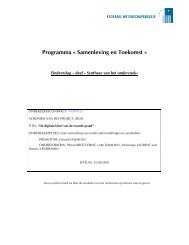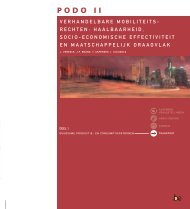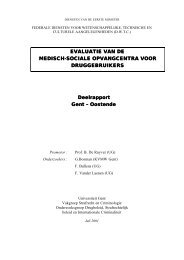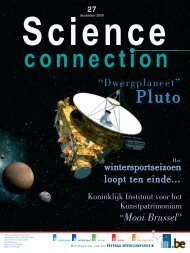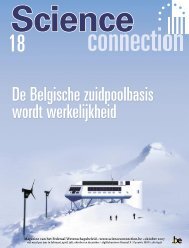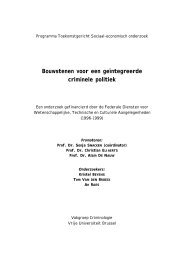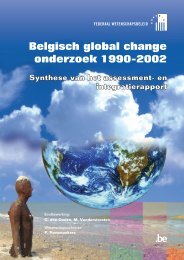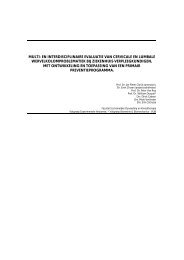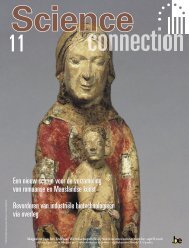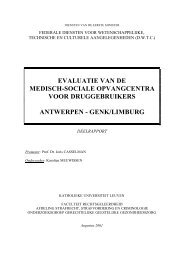chapter 3 inventory of local food systems
chapter 3 inventory of local food systems
chapter 3 inventory of local food systems
Create successful ePaper yourself
Turn your PDF publications into a flip-book with our unique Google optimized e-Paper software.
Project CP/59 - “Instruments and institutions to develop <strong>local</strong> <strong>food</strong> <strong>systems</strong>”<br />
1.3.2. Economic impact<br />
At the economic level, one can also investigate different effects <strong>of</strong> <strong>local</strong> <strong>food</strong> <strong>systems</strong>.<br />
Again, the above-quoted division (community/consumer/ producer) is followed. In<br />
general, one can state that the link which is closest to the consumer decides the price<br />
setting. When <strong>food</strong> products are marketed through mainstream <strong>systems</strong>, this link is<br />
usually the retailer. However, when a number <strong>of</strong> producers take an initiative, they are<br />
the last link in the chain, they decide on the price to be set and they receive the added<br />
value. Another important aspect <strong>of</strong> collective initiatives is the saving in development<br />
and research costs. For instance, the parent organization <strong>of</strong> Fruitnet has built knowledge<br />
concerning integrated growing methods, and this knowledge is transferred to the<br />
members. In this way, farmers have a easier access to information (Verhaegen and Van<br />
Huylenbroeck, 2001).<br />
1.3.2.1. Economic impact at community level<br />
In the same way as employment has been mentioned for the social aspect, LFS also<br />
contribute to community income in an economic context. This happens through the tax<br />
payer on the one hand and through the purchase <strong>of</strong> <strong>local</strong> raw materials and production<br />
means on the other hand. The fact that money circulates longer <strong>local</strong>ly, is equally<br />
important.<br />
Multiplier effect<br />
The <strong>local</strong>-multiplier-3-effect (LM3) measures money expenditure, describing where the<br />
money goes to at the same time. It is <strong>local</strong> because it is for <strong>local</strong>, micro-economic use.<br />
Three stands for the first three rounds <strong>of</strong> spending being measured. First, the initial<br />
incomes are measured, then how this income is spent, and in round three one measures<br />
how much <strong>of</strong> the <strong>local</strong> spending is re-spent <strong>local</strong>ly. Summing the money from all three<br />
rounds, and dividing it by the initial income then makes up the LM3. The resulting LM3<br />
will then <strong>of</strong>fer a general understanding <strong>of</strong> how a variable aspect <strong>of</strong> the <strong>local</strong> economy is<br />
working. It is thus an instrument to measure the impact <strong>of</strong> ‘spending money’ and to<br />
verify where the money goes to (Sacks, 2002).<br />
Impact on employment<br />
Because <strong>of</strong> its social character, the impact on employment has already been mentioned<br />
with the social impact, but it is obvious that it also has an economic resultant. The<br />
accent is specifically on “<strong>local</strong> employment”. One can wonder whether in <strong>local</strong><br />
networks also more persons from the direct environment need to be given employment.<br />
Indeed, <strong>local</strong> employment <strong>of</strong>fers a number <strong>of</strong> advantages (Sacks, 2002):<br />
• for the community: a lower degree <strong>of</strong> unemployment, less pollution <strong>of</strong> the<br />
environment and less traffic jams due to less (or less long) transportation <strong>of</strong><br />
persons,…;<br />
• for the employee: a shorter distance between home and work, such that more use<br />
can be made <strong>of</strong> public transportation means and bicycles, and that traffic jams<br />
can be avoided;<br />
SPSD II - Part I - Sustainable production and consumption patterns - Agro-Food 18



